ORIGINAL PIRATE MATERIAL - THE STORY OF EUROPE'S FIRST GAY FOOTBALL TEAM
Hackney Women’s FC were the first openly gay football club in Europe, probably the world, and their legacy is the progression you see in the game every single day…

Words:
James BirdImages:
“Just to underline how radical it was back then… if you projected forward to when we went to Clacton wearing the EASTBENDERS shirts we’d made, which was probably 20 years after we were formed, we were still the only team who were out and proud in that way.”
A hot nucleus of non-conformists, religious dissenters, and radicals began to descend on the villages of Stoke Newington and Hackney as early as the 1600s, around the time the ‘Dissenting Academies’ started opening. By 1784, Mary Wollestencroft had founded a school for girls based on the revolutionary idea of equal education. 100 years later, and Rev Charles Maurice Davies describes Hackney as “the most heretical of the various quarters of the metropolis” 1949? The anti-fascists boot the fascists out of Stamford Hill. 1970? Centerprise and Hackney Gutter Press, two publishing projects focused on class politics, are launched. Put your finger anywhere on the Hackney timeline and you’ll find the revolutionaries.
Put your finger on Saturday 4th October 1986 and you’ll find The Hackney Broadcasting Authority: a community-led pirate radio station hitting the airwaves for the first time. Its programming included subjects such as the Battle of Cable Street, women’s safety on housing estates, and Latin American history. Bevan Jones, the chairperson of the Community Radio Association, said at the time that ‘The real problem now is not to generate enthusiasm for community radio, but to convince politicians and opinion makers that community radio is valid.” The perennial need for powerful people to listen to the needs of normal people feels familiar.
"Around the same time the HBA started spreading the word of community cohesion and change via 94FM, another group of radicals dressed in red shirts from a PE catalogue were getting to work."
“The stink in there was horrendous, it was left behind for us,” Joanie Evans tells me about the smell of the changing rooms on the South Marshes in the mid 80s. Joanie is a founding member of Hackney Women’s FC, the first openly gay football club in Europe, and most probably the world. “That stink was because our games were in the afternoon, so they were used before us. A lot of the time we would change outside on the side of the pitch. It just wasn’t worth going in.”
Spaces, like airwaves and schools, changing rooms and football pitches, become radical when people with ideas occupy them. Having a women’s team was one idea. The FA’s 1921 ban on women’s football was only lifted in 1971 and with Margaret Thatcher’s Section 28 legislation which prohibited the “promotion of homosexuality” pushed through in 1988—having a club with a constitution setting it out as women-run and majority-lesbian wasn’t just an idea, it was a revolutionary act.
Back in those days, the leagues and cups were so mixed that Joanie and her teammates, that could have included anyone from a Michelin star chef on an all-nighter to someone playing for the first time in a red T-shirt and joggers, might have come up against Arsenal, or West Ham, or Fulham. They even played with Sue Smith, an England legend with 93 caps, player of the year accolades, and one of the first 17 women to be given central contracts by The Football Association.
“Early on in my time, I did two weeks work experience coaching at Arsenal,” Joanie tells me. It’s a chilly Tuesday night in the upstairs room of a pub in north east London. Around the table are other HWFC alumni who started playing for the club between the early 90s and 2000s: Chris Paouros, Naina Patel, and Hannah Taylor who has brought her son with her. They’re the Mount Olympus of grassroots women football pioneers, and it’s a privilege to have them all sat around the table talking about the last four decades of smashing down boundaries and building houses for the future with the remains.
“I was told by one of the players from the women’s first team there ‘You better tell your lot to stop that business because it’s going to set women’s football back 20 years’,” Joanie continues. “I went back and told the club, and everybody just fell about laughing. People get it now. But we used to see all them players from Millwall, Fulham, Arsenal all out on a Saturday night, drinking, getting lairy, and then if you're playing them the next day, it's as if they've never seen you at all.”
If opposition players wanted to pretend they didn’t recognise Hackney, they didn’t really have a choice. And it wasn’t just the iconic shirts.
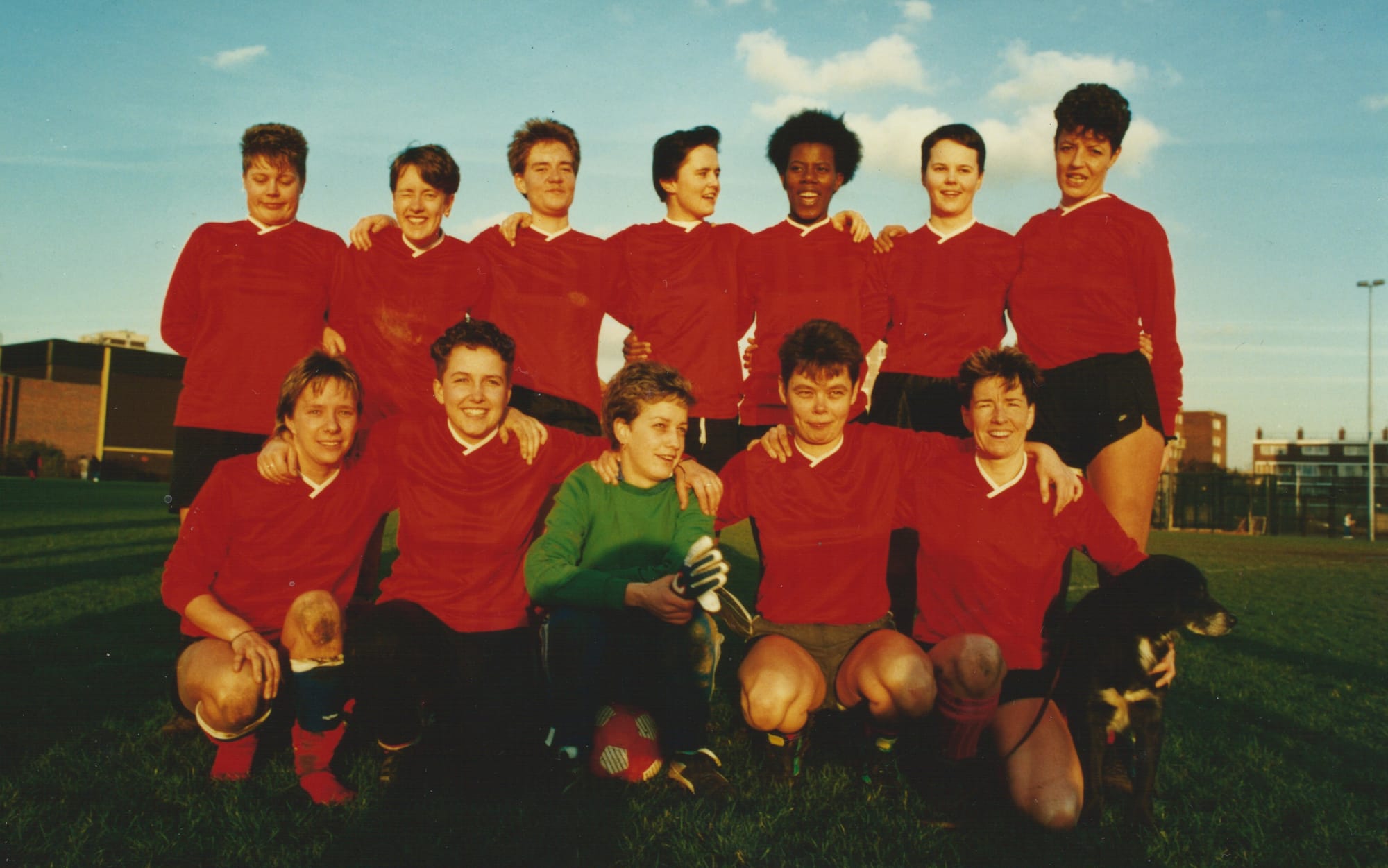
“People always knew who we were,” Hannah Taylor, the club’s archivist says. “A. Because we were noisy. And B, because it was fun. So people wanted to be in that orbit. I think by proxy being out and gay embedded that kind of liberty to be able to just double down on the political side of it. We're already marginalised, we're already out on a limb so actually it made it a lot easier to stick to your guns on who we were as a club and find our own identity. And there hasn't been any wavering, we didn't have male coaches, no wavering for like 30 years. We did it ourselves, we are self run, we will be autonomous.”
To work well, all revolutionary groups have to be autonomous. That’s sort of the point: nobody else is helping us, so we’ll have to do it ourselves. Chris remembers friends ringing her and saying could you help, and her being able to find them a plumber, an electrician, a painter and decorator, a graphic designer, a lawyer, a physio, a photographer. Whether it was having someone who knew their way around a medical box or a sewing box or a design suite, the point was that Hackney Women’s FC would be doing it themselves.
The original Mighty Mighty Hackney Women’s FC flag is a beautiful example of this. The upside down black triangle is a lesbian symbol that has its origins in the Nazi concentration camps, and the double-sided axe, the labrys, was associated as a weapon used by the Amazons of mythology that was adopted as a symbol of empowerment by the lesbian feminist community in the 1970s. That flag is embroidered, and the players would take it everywhere they went. To games, on nights out, to marches.
I ask them how fun it was and now Chris is talking about smoking fags at the beigel shop on Ridley Road in Dalston and Naina is talking about driving in convoys to places like Clacton and there always being at least one massive U-turn and Hannah is talking about the summer 7-a-side tournaments in Cheshire that were like massive parties, with England players getting in some summer minutes amongst them. Joanie is talking about the cabaret nights they’d do, and how she doesn’t know how she did the character acts she did back in those days:
"One was a churchwoman called Deacus who would read from a German bible that was in the house, and another was an elderly man called Delbert."
Then there was Robyn doing the alphabet with her body and the big trips to the countryside for tournaments and the song books they’d write together to sing at marches and the Roadmaster bus they hired for beating Arsenal in the final of the Sue Sharples Cup and the mates who would streak across the pitch and the ridiculous Roman Tortoise freekick rituals they would try and the time they had to move a Portaloo from the middle of the pitch before they could kick off and then there was the dressing up box that Robyn would open up ‘because you basically had a bunch of lesbians who never wore dresses so it was like we were all in drag and we’d do these silly catwalks’.“We was all about having fun,” Joanie says. “And sometimes we get kicked the fuck out of the matches sometimes because players didn't want to necessarily play against us or, or, there was this distance that they'd probably want to come in on us really hard and we were like, Come on, we just want to play.” Naina gets out a pile of the shirts and Chris goes fuckinghell Nains how many have you got? and Hannah and Joanie are beaming.
This is the shirt issue, remember, and HWFC’s archive isn’t just a collection of clothes: it’s a timeline of their history. As Peter Carney, the great flagmaker of Anfield, once called his work the Scouse Bayeaux tapestry, HWFC’s shirts could be considered the Hackney Bayeaux tapestry.
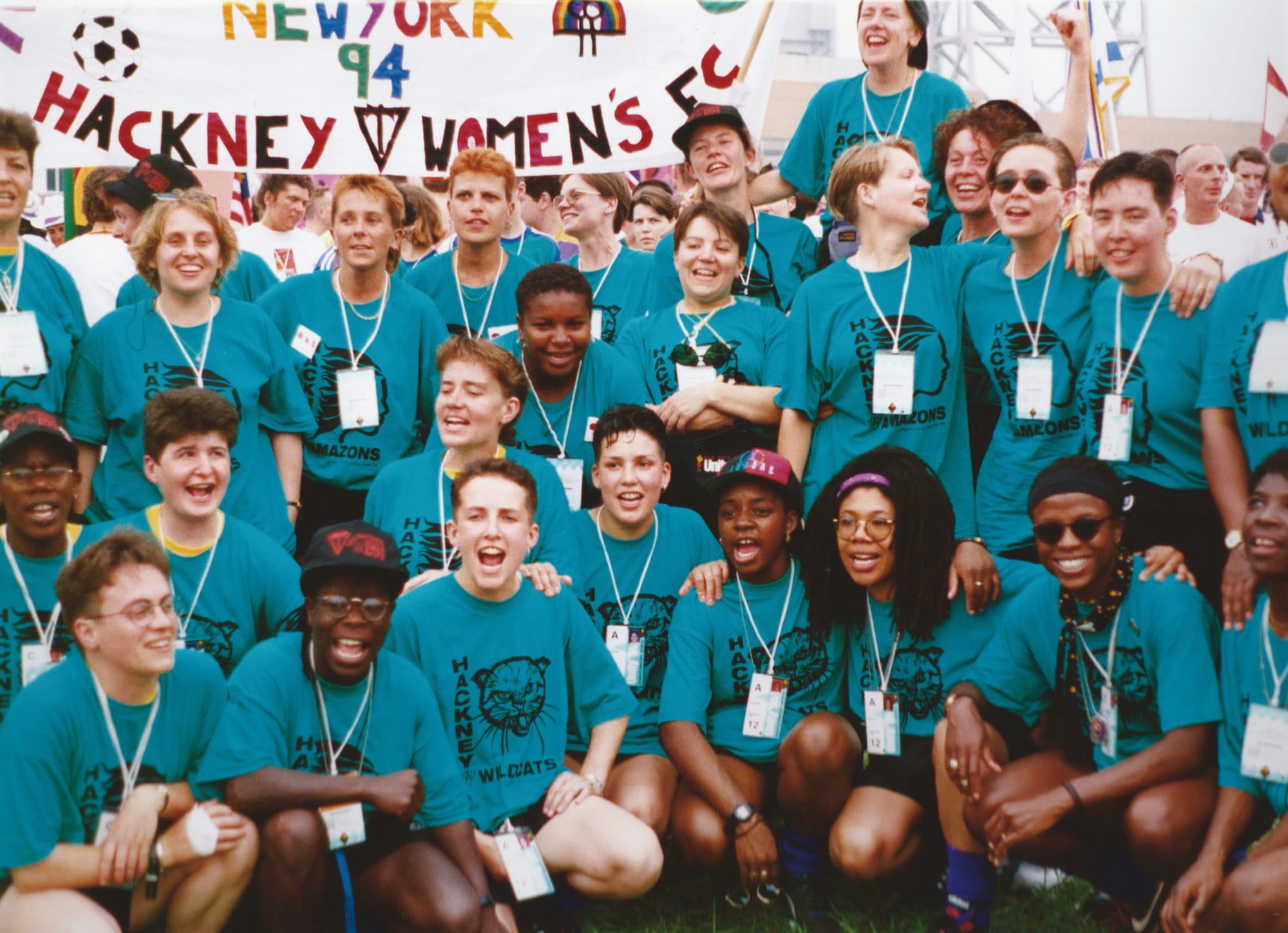
There’s the plain red shirt with an overlapping white collar that was their very first kit: all bought from a school uniform directory sourced by one of the players who was a teacher. There’s the black and red striped rugby style shirt from the late 80s, Joanie puts it in my hand and it’s as heavy as a bag of shopping. There are the amazingly illustrated shirts from the first Gay Games: the Wildcat and Amazon drawn on the front.
"There’s the EASTBENDERS tee that Naina remembers wearing in Clacton and Hannah and Chris talk about how radical it was for 40 or 50 women to be wandering around a right wing stronghold wearing those flapping in the wind."
There’s the take on the French Connection UK logo, HWFCUK, white on a plain black T-shirt that I am begging them to remake so that I can wear, and then there’s the new shirt: a WE ARE FEARLESS sponsor across the front, lesbian iconography embedded into the design, an embroidered badge.
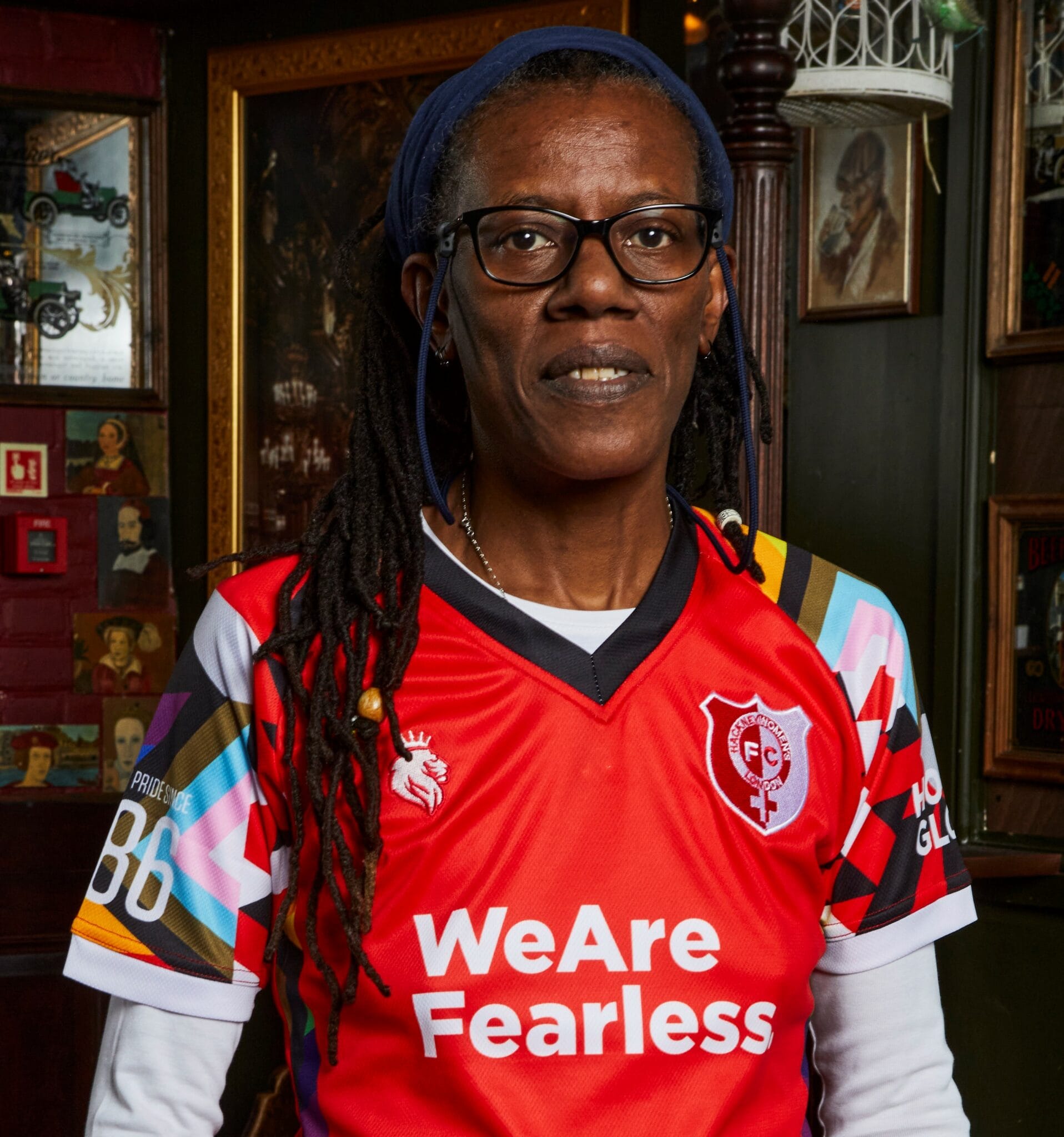
Like all great revolutionary groups, you can trace the history of Hackney Women’s FC through the designs and messages on the things they wore.
The true glory of pirate radio’s heydays was the knowledge that wherever you went there was magic in the air. That, somewhere amongst the normal sounds that everyone else could hear, was something else. After the transmitters moved from ships in the sea in the 60s to tower blocks across the country to the 80s and 90s, a birdseye view of any urban area would reveal a mosaic of secret sounds. Bit of soul on that estate, some jungle from over there, a station pumping out acid house over there and one pinging out drum n bass next to it.
When people with similar interests offer alternatives to the mainstream, the authorities become terrified of losing their regulated influence and come crashing down. It was the summer of 1993 when the Evening Standard ran the headline DRUG GANGS SET UP FORTRESSES after a raid on the Hardcore and Jungle playing Rush station in Lower Clapton, Hackney. The story of concrete blocks, lethal booby traps, and ruthless drug dealers had been cooked up as part of the Tory government’s clamp down on pirate radio. The towers of the Nightingale Estate where Rush emitted their sounds from is just down the road from the Hackney Marshes where HWFC played, and the following summer the club were to embark on their own new adventure.
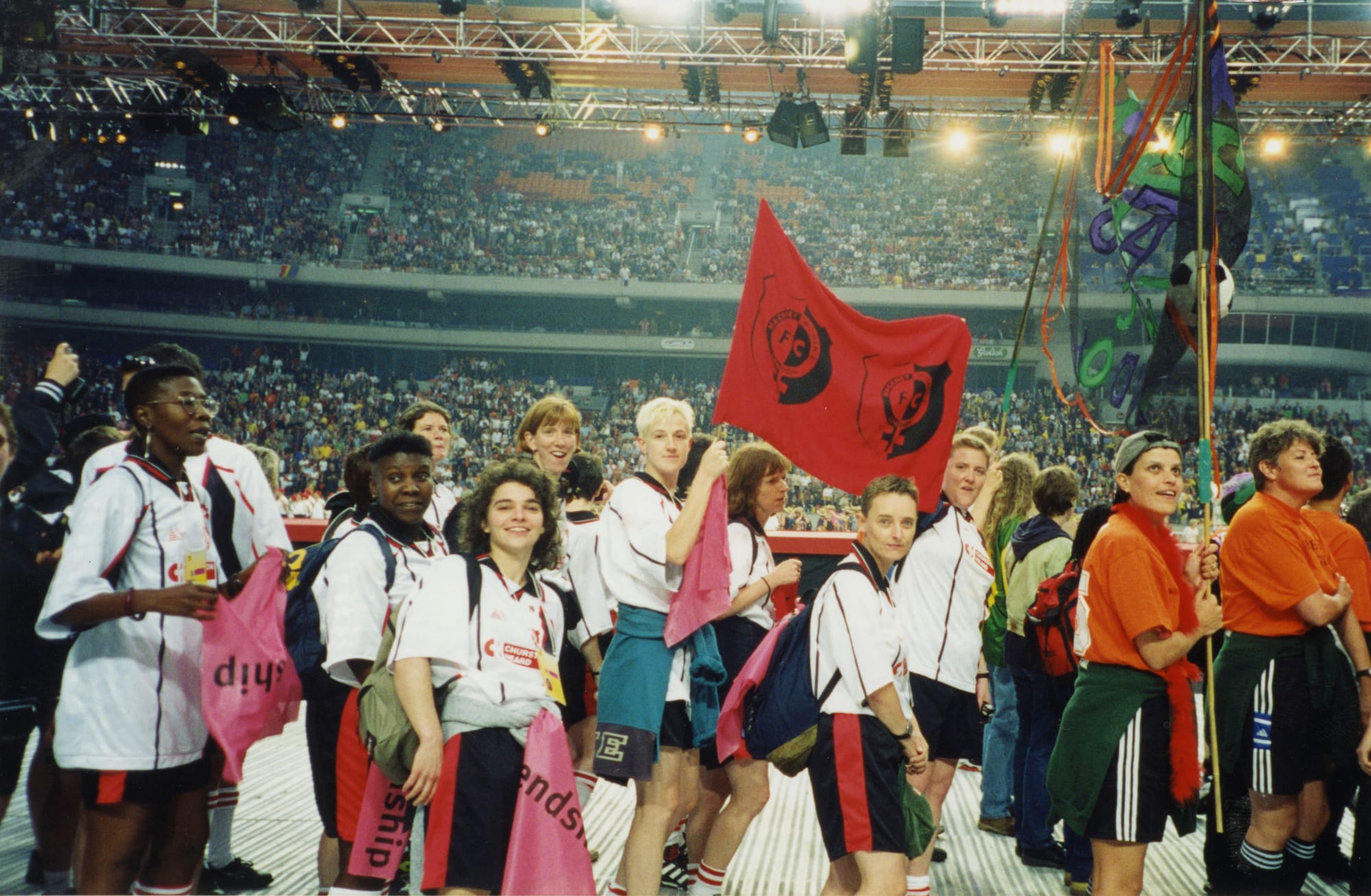
Founded in 1982 as the Gay Olympics, the 1994 Gay Games in New York was held in June to coincide with the 25th anniversary of the Stonewall Riots. With 10,864 athletes involved, it eclipsed the size of the 1992 Barcelona Olympics by 1,500 competitors. Hackney took two teams: the Hackney Wildcats and the Hackney Amazons.
Joanie remembers them all smoking on the plane there, and singing and dancing from the moment it all started to the moment it finished.“If we went past a church and a woman was getting married we’d shout like ‘Don’t do it! I’m coming!’ We thought we were the only lot from the UK going over, but there was another team from South London and then a Stonewall men’s team. And, well, we just went to town.”
“We was playing up at Flushing Meadows, they were like dirt pitches. And we lost every game, but it wasn’t about that. We had one day off from playing football in the week, so on the Tuesday night we got absolutely rattled and then did it again on the Wednesday. We had a blast.”
“Because there were so many of us, we didn’t have to care what anyone thought. All the things you might be worried about, like holding your girlfriend’s hand, we didn’t have to worry about because there were thousands of us. Even on the march, on one side you’d get all the people from the churches with their banners saying “God hates gays” and “Adam and Eve not Adam and Steve” and we’d just laugh, we didn’t even have to think about it.”
The club attended the following Gay Games in Amsterdam in 1998, too, still with that embroidered flag hoisted high, still being the loudest, still having the best T-shirts. And Joanie? Well she’s been co-president of the Gay Games since 2013, and is trying to make sure the club attends the next tournament: Valencia 2026.
The legacy is clear. Wherever you are in the country, things have changed so much in terms of women playing football—not just in the last 30, 20, 10 years, but in the last two years. Looking at stats, the most recent report from 2022 says there were 100,000 new women playing the sport, but what’s more impactful is what you see with your own eyes. Wherever and whenever I play on any astro turf at any level: there are more women playing football. In mixed games, 5-a-sides, waiting on the sideline, it has changed so much.
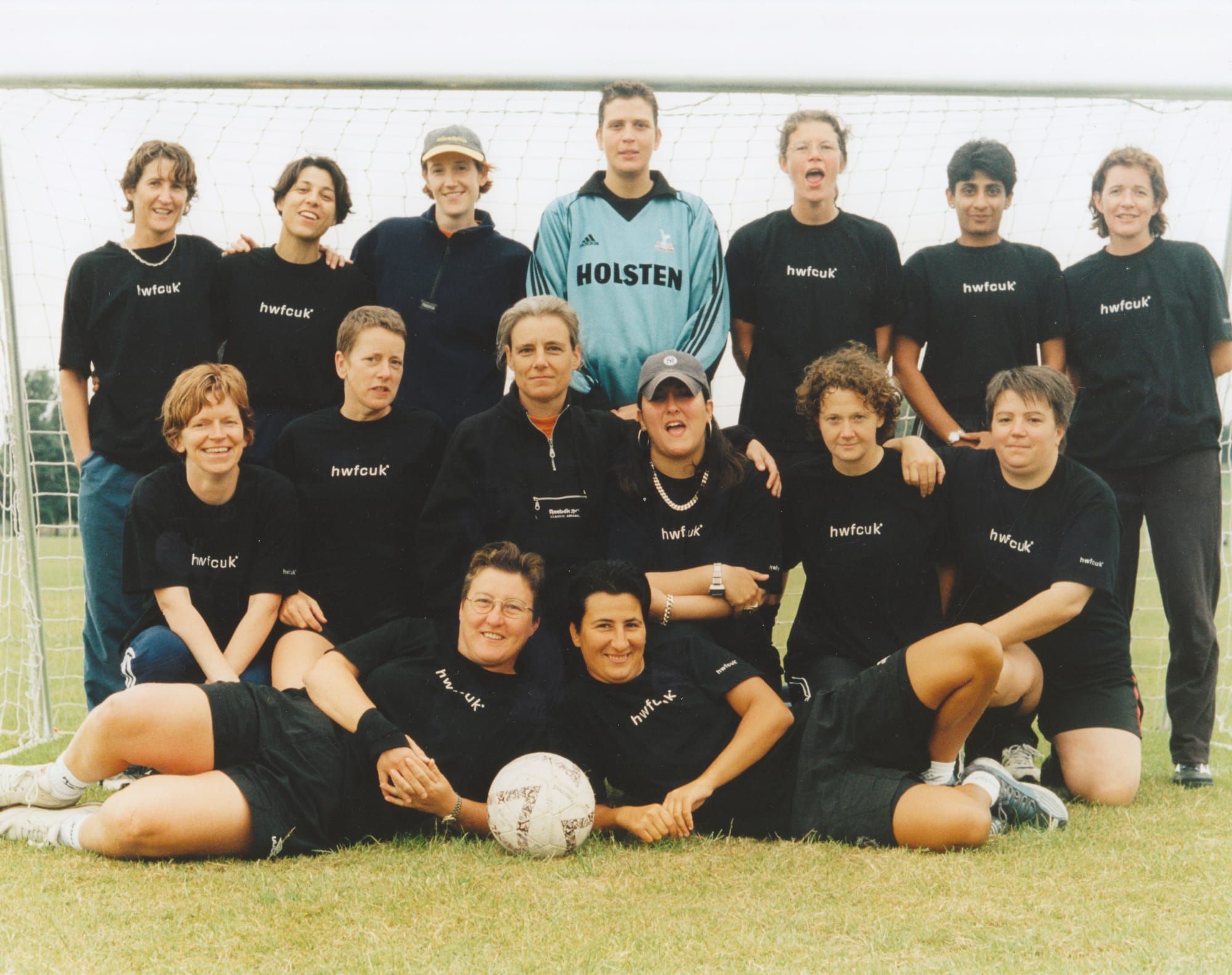
The women around me did the hard yards, took the bile from the sidelines, chewed it up, and spat it out on T-Shirts, on banners, on marches. The progress is their legacy, and as their 40th anniversary approaches in 2026, I ask them what’s next.
“I think the big thing for now is keeping up that connectivity with the younger players,” Hannah says before leaving. “We're bigger than a team now. We are a club, we have a legacy and it's now passing that on. But I do always say to myself, ‘What is our new pioneering thing going to be?’ Is it going to be older women’s football? Is it going to be walking football? You know, we joke about it but we’re not really vets, a vet is over 35, we have women playing who are in their sixties, we are like super, super vets. There’s still a lot of energy and that amazing autonomous skill set. Is it going to be a Hackney Women’s Care home? Is it walking football into our 70s and 80s?”
A hot nucleus of non-conformists, religious dissenters, and radicals began to descend on the villages of Stoke Newington and Hackney as early as the 1600s, and they stayed through its anarchist publishing presses and the community-led pirate radio stations. From where I live, you can still hear the parties held in the wooded areas of the Marshes on Saturday and Sunday mornings in the summer. The duffled bass coming out of speakers hidden in bushes as tired people dance way past breakfast time. If you strain your ears hard enough, you’ll hear it mixing with the noise of the football matches. That hot nucleus, if you peer around the expensive bakers and the old townhouses exploding in value, is still going today.
People like Joanie, Chris, Naina, and Hannah are still moving forward, still sculpting futures, still forcing powerful people to listen to the needs of normal people. Put your finger on that timeline, and Hackney Women’s Football Club will be singing and dancing into your soul.